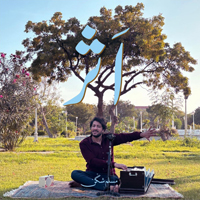
MUSLIM SHAGGAN
ASAR (honiunhoni)
Muslim is a singer in the Hindustani classical style which evolved in the court at the palace of Gwalior centuries ago. Shaggan, however, comes from Lahore which is in Pakistan where he has adapted contemporary and folk styles into his repertoire. He plays harmonium, as you can see from the cover, and it is simple accompaniment to his fine voice. There were three venues for recording: a room, a courtyard and a park, each with different though imperceptible acoustic variations. On the bandcamp page there is a link to a video filmed in the park, to give you a sense of the ambiance. To a non-speaker the songs sound like lovelorn ghazals and geets. I was reminded of the black & white videos of Guru Dutt and other masters from the golden age of Bollywood that I devoured a couple of decades ago. Then the singer was Mohammad Rafi and I must say this evokes that era beautifully. Films like Pyaasa (1957), Kaagaz ke Phool (1959), Awaara, Boot Polish are brimming with his melodious voice. Similarly, Shaggan has a heart-wrenching quality on his lovelorn lyrics; despite sounding generally downcast, it's a mellow outing.
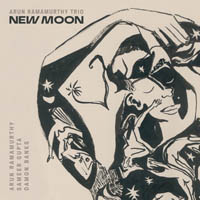
ARUN RAMAMURTHY TRIO
NEW MOON (Greenleaf Music GRE-CD-111)
This is Carnatic music like you've never heard before. Ramamurthy grew up in a musical household in Brooklyn: his mother was a Carnatic singer and his father was a tour manager for visiting acts from the Indian subcontinent. He was trained in Carnatic violin but his brain was always more into Miles and Coltrane, A Tribe called Quest and Radiohead. His trio includes electric bass and martial rock drums and they add a rocking, jazzy edge to his playing that is sympathetic to his multiculturalism. I suppose one touch-stone, not mentioned by Ramamurthy perhaps because he is too young to remember, might be the Mahavishnu Orchestra which featured classically trained Jerry Goodman on violin whose improvisations were a match for McLaughlin on guitar. Be that as it may, only the bass is posed in counterpoint and is actively soloing also, not just holding it down on the one. Sameer Gupta and Damon Banks are the accompanists and the trio really moves as a unit.
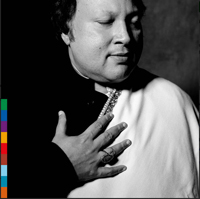
NUSRAT
CHAIN OF LIGHT (Real World Records CDRW256)
Recorded 34 years ago, in 1990, these one-inch magnetic tapes were unearthed in a storage shed. Nusrat would sing all night and ask the producer (Canadian guitarist) Michael Brook to let them know when to stop, but the additional hours of recording had been shelved and forgotten. Of course the album Musst Musst, issued by RealWorld in 1990 was a massive success and led to a much wider awareness of Sufi praise singing. Subsequently Real World issued five more albums of his music, plus remixes. For the next seven years until his death, Nusrat would tour and perform, astounding audiences all over the globe with his virtuosity. To hear him live convinced you that the twentieth century had produced no greater singer (though I am not a fan of opera, those are the only vocalists I have heard mentioned in the same breath). His ever-ascending percussive scat singing was truly breath-taking. Yes, all these references to breath are intentional. Even if you don't understand Urdu or Panjabi when he goes ah-aha-ah-ah-ayyyyiii-aaaaaa-alllahhhh, you are transported. The wordless vocalizing was his trademark and it makes Lambert, Hendricks and Ross sound like Mary and her little lamb. However, Nusrat's oeuvre is all of a piece (there are 348 listings on discogs), so if you buy any random album by him, the chances are you will be impressed. When I worked at Round World Music in San Francisco in the 1990s we had an in-house joke, when people who had Musst Musst would ask us to recommend another Nusrat album we would tell them to check out Live at Islamabad, volume 101. Great, do you have it? No, but you can buy it round the corner on cassette for $5. Because round the corner was an Indian grocery store, smelling of incense, with 10-pound sacks of basmati rice piled up on the floor, and on the wall were hundreds of cheap cassettes of all manner of music from the sub-continent, so we felt it part of our mission to send folks round there to dig a bit deeper. Here, too is a great gift. Four qawwals from the master, beautifully recorded, some appearing here for this first time, all of course unique performances. So roll over Pavarotti, tell Caruso the news, and make some space for Nusrat F. A. Khan.
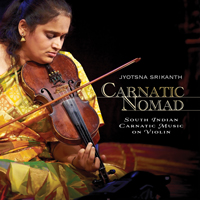
JYOTSNA SRIKANTH
CARNATIC NOMAD (ARC Music International)
Timing is important, not just in creating music, but in hearing it also. Music has its moods and places and if it works out it can surprise you. I tried this new Carnatic violin album a couple of times, but grew restless and changed it before getting into it. Then this morning I put on some Congolese oldies but my Cog player decided it would go back and start in the middle of the Carnatic album. As I had just woken up, I let it go and realized that some albums are best appreciated before you are caffeinated and just emerging from a night of complex dreams where your brain was wrestling with your psyche. Instrumental music is good for thinking anyway, but Indian music especially is good for clearing brain fog and getting your synapses firing. Srikanth takes some famous ragas, ranging from the 15th to the 18th centuries and breathes new life into them, endowing them with emotion and expressiveness as very taut accompaniment on percussion assists the mood. The mridangam, a double-headed drum, keeps the beat while khanjira, a big tambourine, adds flourishes. Both her accompanists get to solo, but the violin is the main attraction, soaring like a lark as it flashes upward into the heavens. Born in Bangalore, Dr Srikanth married and moved to London, where she runs the London International Arts Festival. In 2023 King Chuck awarded her the MBE. Given the state of the "Brutish Empire" this seems ironic, and I wonder if her relocation to the UK has affected her music? In "Ninnuvina" I think I hear elements of Irish folk song. I also had an ear out for Vaughan Williams, but this is totally original, brilliant improvised modern classical music.
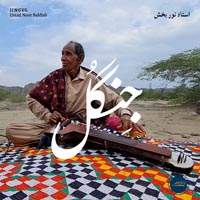
USTAD NOOR BAKHSH
JINGUL (Honiunhoni; available via Hive Mind)
When I first saw the video promoting this album I was electrified. Yes, it is traditional music from Balochistan and you may think I was under the influence of chemical forces, but the presentation and performance of the music was so exciting I couldn't stop watching it, over and over. I had no idea where Balochistan is; it looks like Rajasthan, dry and hot, but apparently it is coastal and a "Jingul" is a type of bird whose song inspired the performer. It's unlikely we in the West can go there to experience this first hand, now that I learn Noor's village is in a strip of land between Afghanistan, Pakistan and Iran. These are countries I would like to visit, but not in this lifetime (though I came close in Jodhpur 20 years ago). Their folk music is about migration and sea travel to Africa, Arabia and Persia. But here's the big kicker: the main instrument, played by Noor, is a toy! Called a Taishogoto, it was created for Japanese children, so one assumes it is conceived and constructed along the lines of a koto. Noor found one in a market in Karachi in the 90s, added a pickup, and now it is an electric Benju. Yes, that sounds like banjo as pronounced by Ed Sullivan... "Now, from Blotchystan, playing the electric benjou, let's give a warm welcome to Noor Baksheesh!" All kidding aside, this guy is not called Ustad, or Master, for nothing: he is a master of this former toy. His benju seems to have keys for stopping frets and sympathetic resonating strings, not to mention an amp to boost the sound. He has two tambour (Damboora) musicians backing him up. Anyone who can remind me of Hans Reichel and J. S. Bach at the same time has my highest respect. For a change the vinyl has more tracks than the digital release: there are 5 downloadable on bandcamp, 11 on the album. The whole thing was done live, one evening sitting by the river, as the sun went down, and the magical hour lives up to expectations.
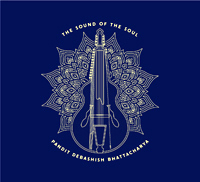
DEBASHISH BHATTACHARYA
THE SOUND OF THE SOUL (Abstract Logix)
The renowned Kolkata-based Indian guitarist has returned post-pandemic with a new tribute album. His last outing in 2017 was a tribute to Hawaiian slide guitar maestro Tau Moe and now he pays homage to another guru, Ali Akbar Khan, in celebration of the 2022 centenary of that master of the sarod. Bhattacharya plays a unique instrument of his own construction, a chaturangui that is a combination of the Hawaiian steel guitar with two dozen sympathetic resonating strings we recognize from the sitar and other Hindustani instruments. It sounds like the older instrument in his hands. To augment the effect is the accompaniment of tabla and pakhawaj, the double-headed barrel drum of South India, also known as Mridangam. The first track, "Ever the Flame Burns," was recorded in Kolkata, then Debashish took up residency in Santa Cruz, California, where he recorded the rest of the album. This is a slow meditative set, quite different from what you may have heard him play with either bluegrass musicians, avant gardeners like Henry Kaiser and Bob Brozman, or the electric fury of Mahavishnu John McLaughlin who recruited Debashish for his Shakti revival in 2001. Swapan Chaudhuri on tabla keeps the beat and enlivens the proceedings in the epic track, "To his Lotus Feet." Once he gets going, the fingers of Bhattacharya blur across the fretboard and demonstrate why John McLaughlin hails him as the best. The final piece "Colors of Joy," has the clearest hints of his lineage, with elements of both Bluegrass and Hawaiian slack-key melodies floating by.
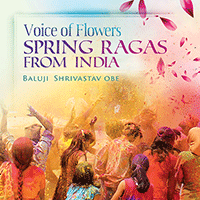
BALUJI SHRIVASTAV
VOICE OF FLOWERS: SPRING RAGAS FROM INDIA (ARC music)
Baluji is a blind, self-taught sitar player. In this 80-minute excursion he animates the colors of flowers, which he cannot see. As you know, ragas are often keyed to specific times of day, and they can also be used to invoke a season, so here we have a set celebrating Spring, known as Vasant (or Basant) in Hindi. The Holi festival, where people throw colored dust on one another, celebrates spring's arrival. Baluji expresses feelings of renewal and hope through the nuances of the repertoire played here. There is an excellent rhythmic counterpart in the tabla playing of Sukhvinder Singh, also known as Pinky, to distinguish him from the playback singer of the same name. In 2012 Shrivastav founded the Inner Vision Orchestra in London comprising 14 blind musicians. He has played with Massive Attack, Annie Lennox, Stevie Wonder and was awarded the OBE in 2016. This is a delight-filled set of classical Indian music for those who enjoy such things.
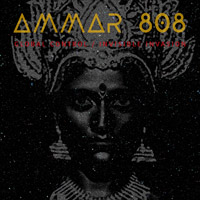
AMMAR 808
GLOBAL CONTROL / INVISIBLE INVASION (Glitterbeat)
I had to double check this was the right disc in the sleeve... I last heard Tunisian musician Ammar 808 playing Arab pop music, which was quirky and engaging. This is Carnatic vocal music from Tamil Nadu in Southern India ("carefully curated source material") which has been treated with loads of echo and beefed up with synth and drum machine. Apparently Sofyann Ben Youssef (the driving force behind Ammar 808) studied sitar and tabla in Delhi so he is at home there too, and presents his treatment of the "Mahabharata" here: I was taken aback at first as it seemed as if the singing and percussion are competing with the synth loops, so I found it quite stressful. It's like a trance-dance tent has been set up outside a temple. On repeated listening however, I do see some interesting conjunctions and it is growing on me. There's dhol beaten furiously and those little squeaky snake-charmer pipes. Of course this sound was pioneered by Bhangra musicians in the UK in the 1990s who treated traditional instruments and vocals with abandon and generated some catchy hits on the way. Then the late Cheb i Sabbah made several trips to India to record local musicians and gave them the works in his lab. Chebi-ji left us a legacy of great recordings and it's welcome to hear a fresh approach to the ever-evolving field of techno-house-dub (or whatever you call it) meeting Indian folk.

NUSRAT FATEH ALI KHAN & PARTY
LIVE AT WOMAD 1985 (RealWorld CDRW225)
Anniversaries pop up all over, deaths, half-centuries and other commemorations remind us of passing time. Woodstock was 50 years ago. I was coming of age in my own way, hitchhiking from the UK to Istanbul with a five pound note sewn into the lining of my jacket. I slept in barns and abandoned cars. The further East I got the more my long hair excited attention, until the problem was solved by the Bulgarian border guards who cut it for me since they did not want any Anarchists coming into their country. I sold my jeans in Sofia to rent a room and buy food, and depended on the kindness of strangers to get by. I got my share of big festivals with tens of thousands of attendees, like the Rolling Stones in Hyde Park after Brian Jones died, and the debut of Blind Faith in the same spot. WOMAD, the music festival started by Peter Gabriel, is celebrating many things (including 30 years of their RealWorld record label) but notably the first appearance of Nusrat Fateh Ali Khan before a Western audience in 1985. He shared the bill with New Order, Rochereau, The Fall and many others. It's also 22 years since his passing. But it's hard to believe it was 15 years between Ravi Shankar breaking out in the West and the emergence of Nusrat. But while they both come from the Indian subcontinent they could not be more different. Ravi was a classical musician who showed a generation of rock guitarists what the art of improvisation was really about. Nusrat had a gift from his God, making him arguably the greatest singer of the second half the twentieth century. He too reveled in spontaneous improvisation, using his vocal chords instead of strings. After WOMAD Nusrat was in demand by Western acts who felt they could improve on the simplicity of his music -- basically singing and handclaps with a harmonium for continuo. At the time RealWorld recorded Love & Devotion in the studio, but decided to overdub mandolin and guitar. Soon after that the remixing began, by Michael Brook, Massive Attack, Dhol Foundation, and others, culminating in the posthumous remixes by Gaudi. Essentially there's nothing new here, if you already have some of the scores of great live Nusrat recordings. But if like me you don't mind listening to another live version of "Alla Hoo" or "Haq Ali Ali" then you should indulge yourself in these twenty-minute versions with extensive vocal improvisation and the dramatic ebbing and flowing of religious fervor that is palpable.
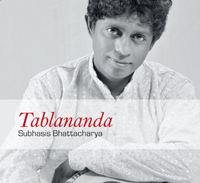
SUBHASIS BHATTACHARYA
TABLANANDA (Riverboat TUGCD1110)
This is the second Bhattacharya family spin-off album I have reviewed in as many months. I think they have a secret pact with World Music Network. However, let me say they are all worthy of your attention (and stand by for a different Bhattacharya coming next month!). I get a lot of music over the transom, and the fact I only post a few reviews per month means I listen to it and evaluate it before most of it gets dismissed: some of it after a few bars because it's crap or irrelevant to me, then there are those with a good opening cut that then go nowhere -- but the ones I like take you on a journey where they already know the route but are willing to make detours and have surprise parties on the way to keep you attentive. Subhasis is the understated tabla accompanist on his brother Debashish's many wild recordings on his homemade guitar. For his first solo outing he assembles an impressive cast of sidemen on western instruments such as guitar or trash can, or Indian instruments like dholak, bansuri or sarangi. The album was recorded in Santa Cruz, California and Kolkata. Subhasis rips through it on his skins like a dervish. He plays a dozen other percussion instruments, according to the liner notes, so I am guessing they overdubbed like crazy. But the layers work well and it seems like most of it was improvised on the spot. For example on "Senegalese Impulse" he brings in Ibou Ngom on sabar and djembe and the two just go at it for four and a half minutes. Intense doesn't begin to describe it. There are waterphones, which sound like Harry Partch devices on "Deep water syllables," and while they are otherworldy, Subhasis fits in well to ground it.

ALI AKBAR KHAN
ROUGH GUIDE (RGNET 1373CD)
There's a nice reference in the liner notes for this new compilation to Claude Debussy's opinion that "music is a matter of colours and rhythmical time." Although i cant find the source of this quote on Google it makes sense: Debussy, like Erik Satie, was interested in mood and expression more than structure and strict tempo. Those French guys created cinematic music before the full potential of the cinema was even realized. And like those two Frenchmen, two Indians shared the world stage a half century later with their similar yet distinct compositions as they popularized Indian classical music beyond the subcontinent. By far the more famous is Ravi Shankar, the Hindu sitar player. On the other hand Ali Akbar Khan, a Muslim, was the maestro of the sarod, a shorter metallic instrument -- the yin to the sitar's yang. And this new Rough Guide takes the same approach as the Rough Guide to Ravi Shankar which came out recently. Early in his career when Khan first recorded, the limitations of the 78 shellac meant you could only fit 3 to 4 minutes on a side of a disc, so he had to take what would be a half-hour long raga and distill it to the essence. Just sketch the story. So we have two opening cuts that are from early in Khan's career (complete with a grinding sound in the background from the surface of the disc), and then three longer tracks from his mature years and we end with a coda that again returns to brevity, as a nightcap. (I think they could have dispensed with the closer, having made the point at the outset, as the sound quality is weaker.) The music is very poetic and evocative -- of many things. My first image is always of black and white riverscapes with reeds because of the powerful impression the Apu trilogy made on me, but then my mind wanders, trains, printing presses, trees, smoke, clouds. Then I think about the relation between tabla and tablature: Indian music is improvised so probably not written down but handed on by demonstration. And you cannot notate accurately the muscular inexactitude in the rhythm of four fingers rapped on a drum in quick succession, bringing us back to those Frenchmen who would say, "imbibet (like a drunk)" or "robotic" rather than commit to presto or lento. The three long pieces on this disc are full of grace and loveliness.
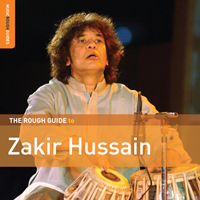
ROUGH GUIDE TO ZAKIR HUSSAIN (RGNET1372CD)
Not all music has to hit you upside the head and make you jump up and down. We all need those peaceful moments when we want to hear some soothing melodies and let our minds wander distractedly without being forced to pay attention to a clever solo. On the other hand even low-key music can draw you into the subtleties and make you hear the gaps or notice the interplay between the percussion and the spaces left by the melody. Zakir Hussain is perhaps the greatest living tabla player. He learned from his father Alla Rakha who preceded him in that elevated position. (I accidentally wrote "table" player which is true, as his father taught him by having him drum along with his fingers as a baby.) With two hands and two small drums he can play melodies or trade licks with the best of them. Here are five tracks that demonstrate his skill. On "Kirwani" he plays along with a santoor, a Kashmiri folk instrument which sounds like a dulcimer, sweet and refreshing like a cool shower on a hot day. Hussain's hands move fast, like talking, his fingers reciting tales, fables, finishing the narrative begun by the strings to the point where he is really excited, making his point, and you are suddenly paying full attention. This compilation is more than a best of: it allows us glimpses of different facets of Hussain's art, mostly in duet with a stringed instrument.
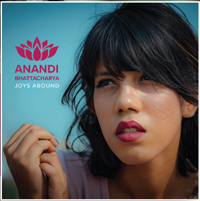
ANANDI BHATTACHARYA
JOYS ABOUND (Riverboat Records TUG1116)
I saw Anandi in concert a few years ago. That is to say, I saw her father Debashish perform in Chicago and he prodded the shy young teen onto the mike to do a number. The good news is she has blossomed into a fine singer and on this album is backed by her dad's band. Debashish plays slide guitar and uncle Subhasis plays tabla. There are guests on djembe, mandolin, keyboards, flute, cajon and percussion but all very unobtrusive. Lata Mangeshkar is now 88 and hopefully enjoying retirement but you cannot avoid a comparison to the fine voice who graced so many (thousands) of popular Hindustani songs. But Anandi also cites Ella Fitzgerald and Joni Mitchell as influences. The music here sounds traditional, and includes an invocation to Ganesh, folk songs, and even a Rabindranath Tagore poem set to music, but all the compositions are original. Included in the band is Carola Ortiz, a clarinetist and singer from Spain who adds another dimension.
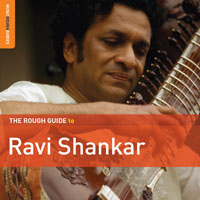
ROUGH GUIDE TO RAVI SHANKAR (RGNET1371CD)
This retrospective look at Ravi Shankar's vast oeuvre has an interesting twist. The compiler, who is also a biographer of the Pandit, has chosen to showcase one raga, "Tilak Shyam," in two versions. The first is an early recording made in the era of 78s which were cut directly to shellac and limited to about 3 minutes (despite what you may think, the sound is fine on this). The second, recorded in 1966 on reel-to-reel tape stretches out to the full 24 minutes of the maestro and his accompanist, Kanai Dutt, in full flight. Starting from Bengali roots, Shankar adapted folk songs (& dance) and rose to the heights of global recognition. His lyrical score for Satyajit Ray's Pather Panchali (1955) won awards at Cannes and promoted Bengali culture to a Western audience. The film was based on a story by Rabindranath Tagore, who won the Nobel for Literature in 1913-- he was the first non-European to do so. Ray adapted other tales for his film Teen Kanya and Shankar collaborated retroactively with Tagore on such masterpieces as Kabuliwala, which has been filmed at least four times. Shankar's global fame was hastened by his association with the Beatles, as well as Western classical musicians like Yehudi Menuhin, but either way, the world was ready for his sophisticated theme and variations and the raga became a popular form of entertainment in the 1960s when people were looking for ways to tune in and relax. Listeners instinctively knew you had to enter the raga and experience it in the moment, and that the performer was facing the same challenge: to follow the instant in interpreting the theme. Shankar's sitar offered morning, evening and night ragas, most of which could be enjoyed at any time of day or state of mind, and no two were ever the same. Another short piece, the 6-minute "Megh" references clouds and is a raga for the rainy season. This CD is abridged from A Journey through his Music, a 10-disc box set that came out on the Document label in 2006. The last track comes from a 1991 live show with Zakir Hussain on tabla, first issued by EMI in India. Like Rabindranath Tagore's stories and Satyajit Ray's films, Ravi Shankar's music is ultimately a monument of human culture.

AKSHARA
IN TIME (Blue-Skinned God Records)
Simply a lovely set of traditional Indian Carnatic music. Despite audible appearances, the group is from New York though they ply traditional instruments: the double-headed barrel-shaped mridangam drum, tabla, bansuri flute and hammered dulcimer. Bala Skandan the leader is the drummer who sets the pace with complex rhythms. He also studied violin as a lad, but the drum was his first love as he could always hear it emanating from temples, unamplified. And if there was a wedding going on, you knew from the sound of the drums. Skandan worked for a while in London (one of the tracks is called "Mind the gap"!) where he would put together Indian ensembles for one-off concerts. Now based in New York he has not hesitated to bring cello and viola into the mix because he feels they fit so well. One cello player got married so he brought in another from Brooklyn Raga Massive and now they have two cello players as needed. The album, of traditional ragas from both the Carnatic and Hindu canon, is perfectly sequenced and at 45 minutes leaves you wanting more.